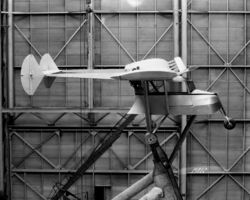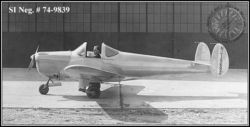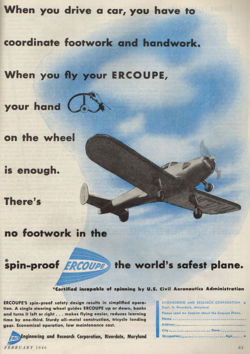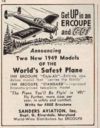PlaneSpottingWorld welcomes all new members! Please gives your ideas at the Terminal.
ERCO Ercoupe
| ERCO Ercoupe | |
|---|---|
| Type | Utility aircraft |
| Manufacturer | Engineering and Research Corporation |
| Designed by | Fred Weick |
| Maiden flight | 1937 |
| Produced | 1940-1970 |
| Number built | 5,685 |
| Unit cost | US$2,665-9,295 |
The ERCO Ercoupe is a low wing monoplane first manufactured by the Engineering and Research Corporation (or ERCO) shortly before World War II. It was designed to be the safest fixed-wing aircraft that aerospace engineering could provide at the time, and the type still enjoys a very faithful following today.
Contents
Pre-history of the Ercoupe
In late 1931, aeronautical engineer Fred Weick was the assistant chief of the aeronautics division of the National Advisory Committee for Aeronautics (NACA). A group of co-workers and he designed and assembled an experimental aircraft in 1934 with a group of his colleagues. Responding to a Bureau of Air Commerce sponsored design competition to build an easy-to-fly, safe aircraft, Weick and his friends worked on the project in their spare time and paid for it themselves.
The test aircraft built by Weick, known as the W-1, featured tricycle landing gear, a high parasol wing, and a pusher propeller configuration. The single engine was used for economy of operation and the tricycle gear was intended to prevent “nose over” landing accidents where the aircraft would flip over on its nose. Weick's design was influenced by the Stout Skycar as well as NACA research, which was first incorporated in the Hammond Y aircraft of 1934.
Weick left NACA in 1936 and joined ERCO's fledgling aircraft team as chief designer, primarily to continue improving his aircraft design. Focusing his efforts on a number of design issues, primarily simplicity and safety, Weick strove to create a reasonably priced aircraft that would not stall or spin. Retaining the tricycle gear (for ease of maneuvering on the ground), Weick switched to a low-wing monoplane configuration in his improved model, powered by a tractor propeller configuration.
The refined W-1A (originally known as the ERCO 310), which included a fully cowled engine, made its first flight in October 1937 and was soon renamed the “Ercoupe.” The twin-tail Ercoupe became an instant sensation because of its easy-to-fly design and unique design features, including a bubble canopy for great visibility. Lacking rudder pedals, the Ercoupe was flown entirely using only a control wheel: a two-control system linked the rudder and aileron systems, which controlled yaw and roll, with the steerable nose wheel. This wheel controlled the pitch and the steering of the aircraft, both on the ground and in the air, simplifying control and coordinated turning and eliminating the need for rudder pedals. A completely new category of pilot's license had to be created for Ercoupe pilots who had never used a rudder pedal.
ERCO Ercoupe
The Ercoupe contained many innovative design features that produced an aircraft that was safe, easy to fly, and certified by the Civil Aeronautics Administration (CAA) as "characteristically incapable of spinning." The aircraft was designed by Fred E. Weick, a noted aeronautical engineer, who before coming to ERCO in 1936, worked for the National Advisory Committee for Aeronautics (NACA). The first experimental model of the Ercoupe was test flown at College Park airport in 1937. Construction of the production prototype was completed in 1939 and certification by the CAA was completed in 1940. The first Ercoupe, serial no. 1, was owned by George Brinckerhoff and flown at College Park Airport, and now belongs to the National Air and Space Museum.
Targeted at the non-professional pilot, the Ercoupe was also designed to be spin-proof with no dangerous stall characteristics. A placard, which was the first for any aircraft, was allowed to be placed proudly on the instrument panel reading: "This aircraft characteristically incapable of spinning." An elevator that could move upward and downward only a limited amount—13 degrees—plus automatic yaw correction, enabled the aircraft to actually fly itself out of a spin. Inexpensive to operate and maintain, the Ercoupe was able to fly into and out of small airfields, and its nose-wheel steering made taxiing almost like driving an automobile. The landing gear was also beefed up to allow for landing in a crabbed attitude in crosswinds since there were no rudder pedals to correct for runway alignment. When the main gear touched town, the side forces were absorbed and the nose would automatically swing forward to align the aircraft with the runway.
The two-seat ERCO Ercoupe 415 went on sale in 1940 but only 112 were delivered before World War II intervened, halting all civil aircraft production. By mid-1941, aluminum supplies were being diverted to war-related production, so ERCO decided to manufacture Ercoupes for military use by using wood as the principal building material. The substitution of wood resulted in a heavier Ercoupe, but the aircraft flew much more quietly because the wood absorbed vibrations from the engine and air flow. Ercoupes were flown during the war by the Civilian Pilot Training Program for flight instruction, and the Civil Air Patrol used them to patrol for German submarines.
Specifications (Ercoupe 415-C)
Data from EAA Museum[1], Federal Aviation Administration[2], Plane & Pilot[3]
General characteristics
- Crew: 1
- Capacity: 1 passenger
- Length: 20 ft 9 in (6.32 m)
- Wingspan: 30 ft 0 in (9.14 m)
- Height: 5 ft 11 in (1.80 m)
- Wing area: 142.6 ft² (13.25 m²)
- Empty weight: 749 lb (339 kg)
- Useful load: 511 lb (233 kg)
- Max takeoff weight: 1,260 lb (572 kg)
- Powerplant: 1× Continental A-65-8 flat-4 engine, 65 hp (49 kW) at 2,300 rpm
Performance
- Never exceed speed: 125 knots (144 mph, 232 km/h)
- Maximum speed: 96 knots (110 mph, 177 km/h)
- Cruise speed: 83 knots (95 mph, 153 km/h)
- Stall speed: 37 knots (43 mph, 69 km/h)
- Range: 261 nm (300 mi, 482 km)
- Service ceiling: 13,000 ft (4,000 m)
- Rate of climb: 550 ft/min (2.79 m/s)
- Wing loading: 8.83 lb/ft² (43.17 kg/m²)
- Power/mass: 0.13 hp/lb (210 W/kg)
Wartime Service
A total of three model 415-C aircraft were procured by the United States Army Air Forces for use during World War II.
| Construction Number |
Construction Date |
Civilian Registration |
Purchase Date |
Army Air Force Designation |
Army Air Force Serial Number |
Service Date |
|---|---|---|---|---|---|---|
| 11 | December 4, 1940 | NC28655 | January 4, 1941 | YO-55 | 41-18875 | February 26, 1941 |
| 110 | NC37143 | August 19, 1941 | XPQ-13 | 41-25196 | December 8, 1941 | |
| XXX | unknown | unknown | unknown | XPQ-13 | 41-39099 | unknown |
First Jet Assisted Takeoff
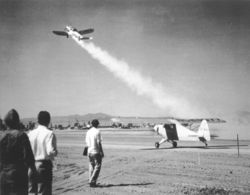
On August 12, 1941, the first Air Corps rocket-assist takeoff was made by a Wright Field test pilot, Capt. Homer Boushey, using a small civilian-type Ercoupe aircraft. Subsequent refinements of this technique were made for assisting heavily-loaded aircraft in taking off from limited space. This technique is still used whenever needed.[5]
Post War Boom and Bust
Although World War II had interrupted production of the Ercoupe, general aviation manufacturers were enthusiastic about the prospects of post-war sales. Thousands of men and women were trained as pilots by the government, and the hope was that they would want to include flying in their civilian life. Production of the model 415-C resumed in 1946, and in that year alone 4,311 aircraft were produced and sold at a cost of US$2,665. This was the same price as in 1941. At its peak, ERCO was turning out 34 Ercoupes per day, operating three shifts per day. The aircraft was aggressively marketed through non-conventional outlets such as the men's department of the Macy's department store chain.
Unfortunately, however, private aircraft sales slumped after the war and the bottom dropped out of the civil aircraft market in late 1946, bursting the bubble held by many aircraft manufacturers, who had expected that post-war prosperity plus a huge number of newly trained pilots would translate into a boom market for civil aircraft sales.
Specifications (1949 Ercoupe 415-G)
Data from Plane & Pilot[6], Federal Aviation Administration[7]
General characteristics
- Crew: 1
- Capacity: 1 passenger
- Length: 20 ft 2 in (6.26 m)
- Wingspan: 30 ft 0 in (9.14 m)
- Height: 5 ft 6 in (1.7 m)
- Wing area: 142.6 ft² (13.25 m²)
- Empty weight: 815 lb (370 kg)
- Max takeoff weight: 1,400 lb (640 kg)
- Powerplant: 1× Continental C-85-12F , 85 hp (63 kW) at 2,575 rpm
Performance
- Never exceed speed: 125 knots (144 mph, 232 km/h)
- Maximum speed: 99 knots (114 mph, 183 km/h)
- Cruise speed: 96 knots (110 mph, 178 km/h)
- Stall speed: 37 knots (43 mph, 69 km/h)
- Range: 360 nm (4101 mi, 670 km)
- Service ceiling: 13,500 ft (1,070 m)
- Rate of climb: 550 ft/min (2.8 m/s)
Other Manufacturers
Sanders Aviation
ERCO sold its remaining Ercoupe inventory to Sanders Aviation in 1947, which continued to produce the aircraft in the same ERCO-owned factory. A total of 213 aircraft were sold by 1950.
UNIVAIR, Part 1
Universal Aircraft Industries of Aurora, Colorado purchased the Ercoupe design from the Engineering and Research Company in 1950. They provided spare parts and customer support to the then existing models. UNIVAIR sold the project to the Forney Aircraft Company in April, 1955.
Forney / Fornaire Aircoupe
In April 1955, Univair sold the Federal Aviation Administration aircraft type certificate for the Ercoupe to the Forney Aircraft Company of Fort Collins, Colorado, which later became the Fornaire Aircraft Company. This aircraft was similar to the 415-G except for engine and propeller combination, revised engine cowling, outer wing panels, metal covered, baggage compartment extended, modifications of seats and instrument panel. Production began in 1958 and ended in 1959
- 56 of the F-1 Forney Delux were produced in 1958 for US$6,995 each.
- 59 of the F-1 Forney Explorer, Execta and Expediter were produced in 1959 for US$6,995 each.
- 23 of the F-1A Forney Trainer were produced in 1959 for US$7,450 each.
A total of 138 aircraft were produced.
Air Products Company Aircoupe
Between August 1960 and March 1964, the rights to the Aircoupe aircraft were held by the AirCoupe division of Air Products Company of the City of Carlsbad, New Mexico. The company was established by the city, with the hope of establishing aircraft manufacture as a local industry. They purchased the type certificate from Forney when a potential deal with Beechcraft had fallen through. Only a few planes were ever produced before the type certificate was sold to Alon, Incorporated on March 16, 1964.
- 25 of the F-1A Forney Trainer were produced in 1959 for US$7,450 each.
Alon Aircoupe
Alon, Incorporated was started by John Allen (whose first two letters from his last name formed the AL) and Lee O. Higdon (whose last two letters from his last name formed the ON).
The two were part of a group of executives who retired from aircraft manufacturer Beechcraft to found their own company. They had previously negotiated with Forney Aircraft to purchase production of the Aircoupe so that Beechcraft could use the design as an introductory trainer. The deal was canceled by Olive Ann Beech, instead deciding to concentrate resources on the Beechcraft Musketeer. This decision caused the executives to leave Beechcraft. They set up shop in McPherson, Kansas where they purchased the type certificate for the Aircoupe from the City of Carlsbad, New Mexico on March 16, 1964.
"A new company formed by former Beechcraft executives Allen and Higdon, who have purchased all assets, jigs, tools, and engineering of the program from the city of Carlsbad NM. They expect to deliver the first of 30-50 Aircoupes to be built next year for about $8,000." (-- Aviation Week 3/30/64)
The Alon A-2 and A-2A Aircoupes were much improved upon models of the original Ercoupe which differed from it in several ways. The Alons featured a sliding canopy, a more powerful 90 hp (up from 75) Continental engine, separate bucket seats and a much improved instrument panel.
Over the period of production (1964-1967) Alon produced 245 A2s, with peak production of 137 in 1966. The last 25 A2s produced by Alon had spring steel landing gear in the place oleo struts.
Another aircraft produced by Alon (although only a single example was ever built) was the A4. The A4 was a low wing 4 place monoplane of aluminum construction powered by a single 150hp Lycoming engine. By accounts, it was a promising aircraft, but it did not go into production before Alon closed.
Production of the A2 ceased in September of 1967, and on October 9, 1967, Alon was purchased by, and became a division of the Mooney Aircraft Company of Kerrville, Texas.
Specifications (1967 Alon Aircoupe A2-A)
Data from Federal Aviation Administration[7]
General characteristics
- Crew: 1
- Capacity: 1 passenger
- Length: 20 ft 4 in (6.43 m)
- Wingspan: 30 ft 0 in (9.14 m)
- Height: 5 ft 7 in (2.1 m)
- Wing area: 142.6 ft² (13.25 m²)
- Empty weight: 930 lb (420 kg)
- Max takeoff weight: 1,450 lb (658 kg)
- Powerplant: 1× Continental C-90-16F , 90 hp (67 kW) 2,475 rpm
Performance
- Never exceed speed: 125 knots (144 mph, 232 km/h)
- Maximum speed: 112 knots (129 mph, 207 km/h)
- Cruise speed: 108 knots (124 mph, 200 km/h)
- Stall speed: 45 knots (52 mph, 84 km/h)
- Range: 450 nm (520 mi, 830 km)
- Service ceiling: 17,300 ft (5,270 m)
- Rate of climb: 640 ft/min (3.25 m/s)
Mooney A2-A and M-10 Cadet
"1968, Mooney now produced the twin tail Alon Aicoupe A2 as the Mooney A2-A. The factory moved to Kerrville, TX, late in 1968. There they re-designed the fuselage from the cockpit back. Now, the Mooney A2-A could be recognized by the square windows behind the sliding canopy. Even as they produced the A2-A Cadet, the Mooney engineers were busy re-designing the coupe into something uniquely Mooney and completely un-weick-like.
On February 23, 1968, the first Mooney Cadet M-10, single tailed in the conventional manner, flew. But meanwhile, the production line still turned out the A2-A twin tailed Cadet."
The Ercoupe A Touch of Class by Frank Rytenhyde Saletri
UNIVAIR, Part 2
The type certificate was sold again (and as of 2006, for the final time) to Univair Aircraft Corporation of Aurora, Colorado in October, 1974.
Legacy
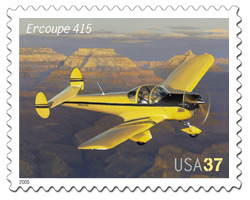
Although no new Ercoupes have been produced since 1970, many spare parts are still available. Univair has owned the type certificate since 1974 for all Ercoupe models, and continues to produce parts as well as provide techinical assistance to Ercoupe owners. Ercoupe owners also enjoy an active type club that helps to organize and efficiently distribute updated information about their aircraft.
Renewed interest in the older models of the Ercoupe, the 415-C and the 415-CD, has been sparked by its status as the only existing, certified tricycle-geared aircraft that meets the FAA's new light-sport aircraft definition. This enables it to be piloted by holders of a sport pilot certificate.
Museum displays
- c/n 1, NC15692
- National Air & Space Museum in Suitland, Maryland [1] (in storage, not on display)
- c/n 57, NC28961
- EAA AirVenture Museum in Oshkosh, Wisconsin [2]
- c/n 1188, N78X
- Pima Air and Space Museum in Tucson, Arizona [3]
- c/n 1265, NC93942
- College Park Aviation Museum in College Park, Maryland [4]
- c/n 1766, NC99143
- Virginia Aviation Museum at Richmond International Airport, Richmond, Virginia [5]
- c/n 1805, NC99182
- College Park Aviation Museum in College Park, Maryland [6]
- c/n 1876, G-EGHB
- Gatwick Aviation Museum at London Gatwick Airport near Charlwood, England [7]
- c/n 2364, NC99741
- Florida Air Museum at Sun 'n Fun in Lakeland, Florida [8]
- c/n 2979, N2354H
- American Airpower Heritage Museum (part of the Commemorative Air Force) in Midland, Texas [9]
- c/n 3014, N2389H
- 1941 Historical Aircraft Group Museum in Geneseo, New York [10]
- c/n 3085, N3180H
- Carolinas Aviation Museum in Charlotte, North Carolina [11]
- c/n 3234, CF-LAK
- Atlantic Canada Aviation Museum in Halifax, Nova Scotia, Canada [12]
- c/n 3569, N2944H
- Museum of Flight in Seattle, Washington [13]
- c/n 3813, N3188H
- South Yorkshire Aircraft Museum in Doncaster, England [14]
- c/n 4770, C-FFYA
- Alberta Aviation Museum in Edmonton, Alberta, Canada [15]
- c/n 5055, N3430H
- Mid-Atlantic Air Museum in Reading, Pennsylvania [16]
- Dakota Territory Air Museum in Minot, North Dakota [17]
- Reynolds-Alberta Museum in Wetaskiwin, Alberta, Canada
- Svedino's Automobile and Aviation Museum in Ugglarp, Sweden [18]
- Western North Carolina Air Museum in Hendersonville, North Carolina
- Yanks Air Museum in Chino, California [19]
References
- ↑ Ercoupe 415-C Specifications. EEA Aviation Center. Retrieved on 2007-01-18.
- ↑ FAA A-718.pdf Aircraft Specification No. A-718 (PDF). Federal Aviation Administration.
- ↑ Colby, Douglas; Corban, Bud; Cox, Bill (April 2005). "Flying for Peanuts". Plane & Pilot. Retrieved on 2007-01-18.
- ↑ The Ercoupe is a "warbird".
- ↑ Rato. National Museum of the United States Air Force.
- ↑ 1949 Ercoupe 415-G. Plane & Pilot. Retrieved on 2007-01-18.
- ↑ 7.0 7.1 FAA A-787.pdf Type Certificate Data Sheet Number A-787 (PDF). Federal Aviation Administration.
- Andrade, John M. (1979). U.S. Military Aircraft Designations and Serials Since 1909. Midland Counties Publications. ISBN 0-904597-22-9.
- Buffardi, Louis N. (1980). Ercoupe. Akron, OH: ESSCO.
- Thomas, Stanley G. (1991). The Ercoupe. Blue Ridge Summit, PA: TAB Aero. ISBN 0-8306-7016-5.
- Weick, Fred E. and Hansen, James R. (1988). From the Ground Up. Washington D.C.: Smithsonian Institution Press. ISBN 0-87474-950-6.
- "Abandoned & Little-Known Airfields: Maryland: Central Prince George's County area", by Roger Freeman, Abandoned & Little-Known Airfields, retrieved January 13, 2006
- "CAC Manuscripts: MS 162", by Marilyn Levinson, Center for Archival Collections, Bowling Green State University, retrieved January 15, 2006
- "College Park Aviation Museum: History: ERCO", College Park Aviation Museum, retrieved January 12, 2006
- "ERCO Ercoupe", by Roger Guillemette, US Centennial of Flight Commission, retrieved January 12, 2006
- "ERCO 415-C Ercoupe", National Air and Space Museum, retrieved January 12, 2006
- "American airplanes: Ab - Ak", Aerofiles, retrieved January 15, 2006
- "American airplanes: Al - Av", Aerofiles, retrieved January 15, 2006
- "American airplanes: Ea - Ew", Aerofiles, retrieved January 15, 2006
- "American airplanes: Fa - Fu", Aerofiles, retrieved January 15, 2006
External links
Related content
Comparable aircraft
See also
Lists relating to aviation | |
|---|---|
| General | Timeline of aviation · Aircraft · Aircraft manufacturers · Aircraft engines · Aircraft engine manufacturers · Airports · Airlines |
| Military | Air forces · Aircraft weapons · Missiles · Unmanned aerial vehicles (UAVs) · Experimental aircraft |
| Notable incidents and accidents | Military aviation · Airliners · General aviation · Famous aviation-related deaths |
| Records | Flight airspeed record · Flight distance record · Flight altitude record · Flight endurance record · Most produced aircraft |
